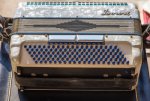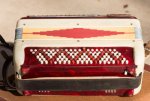L
logista
Guest
Hello, Im so glad I found you all.
I have 2 accordions that my sister and I played when we were children. They were stored in a musty basement for over 25 years, so Im pretty sure theyre not worth fixing. However, before I tear them apart for collage and other stuff, I want to be sure that theyre not somehow interesting to someone as they are.
https://68.media.tumblr.com/d68aa2e5041480ddd9d1794ae75011d3/tumblr_oglfdwsCHs1qzt7lgo2_400.jpg>
https://68.media.tumblr.com/5237be02f78b8360775ddcb61bd681cd/tumblr_oglfdwsCHs1qzt7lgo4_400.jpg>
(In case the photos dont load for you, you can see them on my Tumblr post here)
The blue one is a Dorovi made in Italy (2415 is also marked on it). I think it was purchased new in the early 1970s but Im not positive.
The red one is a Nobility Accordion from Chicago, made in Italy. It was purchased used in the early 1970s.
Thank you in advance for any advice!
I have 2 accordions that my sister and I played when we were children. They were stored in a musty basement for over 25 years, so Im pretty sure theyre not worth fixing. However, before I tear them apart for collage and other stuff, I want to be sure that theyre not somehow interesting to someone as they are.
https://68.media.tumblr.com/d68aa2e5041480ddd9d1794ae75011d3/tumblr_oglfdwsCHs1qzt7lgo2_400.jpg>

https://68.media.tumblr.com/5237be02f78b8360775ddcb61bd681cd/tumblr_oglfdwsCHs1qzt7lgo4_400.jpg>

(In case the photos dont load for you, you can see them on my Tumblr post here)
The blue one is a Dorovi made in Italy (2415 is also marked on it). I think it was purchased new in the early 1970s but Im not positive.
The red one is a Nobility Accordion from Chicago, made in Italy. It was purchased used in the early 1970s.
Thank you in advance for any advice!
